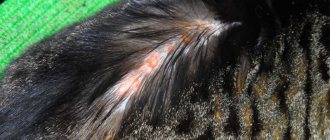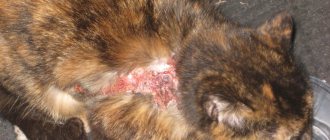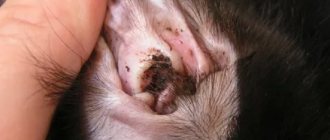It is generally accepted that the distributor of allergens in pets is the fur, on which particles are brought into the house from the street. But is there an allergy to Sphynxes, since this breed is almost hairless?
It is difficult to imagine comfort in a home without an affectionate pet. For many people, communicating with an animal is a kind of break from everyday routine affairs. Of the many known breeds, of course, it is worth getting a cat without harming your health or individual characteristics of the body. When choosing a pet, many people pay attention to the coat. Sphynxes do not have hair, but allergy sufferers and asthmatics are still advised to take a closer look at another, less allergenic breed.
Are there allergies to hairless cats?
The manifestation of allergies is provoked by a protein, such as a specific protein contained in the urine, saliva, and sebaceous glands of animals.
But is there an allergy to hairless cats? This particular breed is a carrier of a large number of allergens, unlike other owners of long hair. It's all about increased protein production against the background of increased sweating, and 2-3 times stronger than in other breeds. Sphynxes sweat a lot, despite their hairless skin. People suffering from allergies, asthma and excessive weakness of the immune system are not resistant to the manifestation of allergic reactions after communication or contact with these animals. Of course, the immune system begins to react to the protein, entering into an active fight and perceiving the protein as “foreign”. However, the entry of allergens into the body of weakened people when staying close to sphinxes leads one way or another to the appearance of unpleasant signs of allergy: lacrimation, sneezing, runny nose, itching on the skin.
REFERENCE! There are no completely hypoallergenic animals in the world. This also applies to completely hairless Sphynxes of the Canadian, Don breed.
Breeders do not recommend having such animals, especially if there are small children living in the house. If you really want to have a four-legged friend, then it’s better to take a closer look at a cat, because unlike cats, their protein production is significantly slower. You should also not neglect personal hygiene measures and constant care of your pet.
Natalya Romanova, breeder of Sphynx cats in the “MORNING” program on STV
Causes of intolerance
Proteins are found in sphinxes' urine and feces. Proteins are also produced by the salivary glands. People experience intolerance and an allergic reaction if these allergens enter the body through the mouth, nose and breathing.
The immune system begins to actively release histamine (a protein), which provokes a failure of the respiratory system and the unpleasant consequences of allergies. Of course, you cannot completely protect yourself in case of individual intolerance, because the allergen is in the air everywhere and is in the body of almost every person. You can only minimize possible manifestations of allergies: protect yourself from contact with allergenic pets or bathe them more often, and monitor your skin.
REFERENCE! Allergists do not advise ignoring allergy symptoms. It is better to visit an immunologist or allergist at an early stage to find out the provoking factors of the harmful effects on the body.
Perhaps the cause of the allergy is not in the cat at all and a full diagnosis is required. Although the consequences of the disease, up to anaphylactic shock, can be extremely serious.
Symptoms
Signs of special sensitivity to sphinxes can be very different: from the eyes, respiratory tract, skin. This presents some difficulties in establishing an accurate diagnosis when the symptoms are similar to other diseases. When the immune system responds, swelling, itching, peeling, and redness appear on the skin.
Usually the symptom has a limited area of damage and appears in areas most often in contact with animals. It happens that allergies cover the entire body, leading to severe itching, scratching, and the appearance of small scaly ulcers. Other catarrhal symptoms for disorders of the eyes and respiratory organs:
- dry, prolonged or paroxysmal cough with sputum;
- spasms in the bronchi;
- runny nose;
- dyspnea;
- sneezing;
- nasal congestion;
- swelling of the mucous membrane of the sclera;
- lacrimation;
- conjunctivitis;
- redness of the eyes;
- difficulty breathing.
Such allergy symptoms are not so harmless; allergy sufferers will repeat episodes in the form of an increasingly worse reaction if no measures are taken.
The appearance of Quincke's edema with signs of suffocation in the larynx, anaphylactic shock against the background of a sharp functional failure in the human body cannot be ruled out. The consequences are difficult to predict. At the first manifestation of unpleasant signs such as dermatitis, urticaria on the skin, laryngeal edema, you should see a doctor.
Are all hairless cats dangerous for allergy sufferers?
Canadian and Don Sphynxes are recognized as dangerous cats for allergy sufferers, differing from each other solely in their origin. These are hairless cats, but in people who are overly hypersensitive, they can cause unpleasant allergy symptoms.
What to do, because there are no allergy-free cats in the world. But the allergen is not wool, but a protein contained in dead epithelial cells, saliva, and urine. It is worth understanding that to the question: can there be an allergy to sphinxes, the answer is that any cat can cause an allergic reaction, despite the fact that it is hairless.
Almost all Sphynx cats sweat a lot. Cats produce fewer allergens, unlike male cats, which are recommended to be neutered when brought into the house. Although, of course, even kittens of this breed, without exception, pose a danger to allergy sufferers to one degree or another.
IS IT WORTH OWNING A SPHINX?? PROS AND CONS OF THE BREED
Are children allergic to Sphynx dogs?
The child's body is imperfect, especially sensitive and may respond inadequately to the protein produced by sphinxes. Despite the lack of fur, these cats may well have a negative reaction from the body.
It is in hairless cats that the protein to which allergies occur is produced 3-4 times stronger than in breeds with fur. Children love to play with animals, but immunity remains extremely unstable until the age of 5-6. Of course, a child’s allergies manifest themselves not only from wool, but from plant pollen, street dust that settles on the animal’s body. An allergy to sphinxes in children often appears instantly if there is excessive sensitivity to this protein. And this:
- dyspnea;
- diarrhea;
- hives;
- bronchospasms;
- paroxysmal cough;
- wheezing;
- pain, colic in the abdomen;
- difficulty urinating;
- temperature increase;
- weakness;
- feeling of lack of air;
- redness, itching, scratching on the skin.
Children are more difficult to tolerate allergies than adults. Signs may cause suffocation, swelling of the larynx with the ability to completely block the airway. Babies become whiny, refuse to eat, and begin to breathe with their mouths open, which leads to dry mucous membranes in the mouth. In addition, with constant scratching of blisters on the body in children, the risk of infection and bacterial infection increases. Parents need to be more attentive and understand when to sound the alarm and consult a doctor.
Could it be that the allergy to the Sphynx arose after some time?
Of course, allergies to hairless cats do not always manifest themselves instantly. The fact is that allergens first accumulate in the body and then begin their harmful effects. Also, the individual characteristics of the body and the degree of histamine surge in the blood play a significant role.
Allergies can be detected by the following signs:
- sneezing that does not bring relief;
- itching, burning sensation;
- clogging cough with a feeling of rawness in the throat;
- runny nose with discharge of foamy, watery mucus from the nose, causing a lot of inconvenience when medications become useless;
- burning sensation on the body like urticaria;
- puffiness around the eyes.
Signs can be delayed, some time after communicating with sphinxes, and they can be very different.
On a note! It is not difficult to recognize the presence of an allergy to the Sphynx; it is enough to place the pet on your lap. Wait for reaction for 2-3 minutes. If primary unpleasant signs of allergies appear, then owning such a breed is extremely undesirable.
In allergy sufferers with weak immunity, the body clearly reacts to any harmful substances mistaken for viruses or bacteria. The immune system begins to actively fight them, but even a small piece of animal hair located on the tail or muzzle can provoke an allergy attack in predisposed people.
Unpleasant consequences should be expected when your pet's saliva spreads throughout the room. Allergies will begin to appear as they accumulate in carpets, flooring, rugs, and upholstery.
Some of the allergens are brought in by the pet from the street, while others are in the air indoors along with dust. That is why it is so important to wet clean the room more often, use air purifiers and humidifiers.
Treatment
Allergy to hairless cats is treated with a standard set of drugs used to relieve characteristic symptoms. The best way to bring the body back to normal is to limit or completely eliminate the possibility of contact with the source of irritation, that is, the cat.
Medications that help alleviate allergic relapses are divided into several main groups:
- Antihistamines. Available in different forms: tablets, sprays, ointments and gels, suspensions, injections. They neutralize histamine receptors, due to which the patient’s well-being significantly improves. The most commonly prescribed are Telfast, Zyrtec, Loratadine, Suprastin.
- Nasal sprays. Designed to relieve swelling of the nasopharyngeal mucosa and restore nasal breathing. With prolonged use they are addictive. These include: Naphthyzin, Sanorin, Noxprey, Nazivin.
- Corticosteroids (hormonal drugs). They have an anti-inflammatory and anti-edematous effect, but if used incorrectly they can cause adrenal failure. The most common in medical practice: Prednisolone, Hydrocortisone, Cinacort, Diprospan.
Important: if we are talking about severe allergic reactions (Quincke's edema, anaphylactic shock), then self-medication is strictly contraindicated. To provide assistance, the patient must be urgently taken to the hospital.
How to understand that a hairless cat has provoked an allergic attack?
It is better to leave your pet in good hands while undergoing diagnostics. It is important to find out what causes the allergic reaction. Maybe the provocateur is not a sphinx at all and there is no point in parting with your beloved pet.
Which doctor should I contact?
If unpleasant signs of an allergy appear, you should visit an allergist. If you are concerned about itching or a rash on your body, see a dermatologist.
Necessary research
When conducting research, you need to work with a specialist to find out the sources of allergies. The main laboratory examination is blood allergy tests, which allow an accurate diagnosis to be made.
If it is revealed that the source of the allergy is the sphinx, then it is advisable to completely avoid contact with it. At the very least, introduce restrictions if it’s impossible to part with your beloved animal. In addition, allergies do not occur to the protein secreted by the sphinx, but to shampoos, gels, and other cosmetics used when bathing.
Main symptoms
The main symptoms include:
- skin itching;
- red rash;
- red spots of various shapes;
- digestive system disorder;
- ulcers on the skin, mucous membranes, oral cavity, accompanied by pain and itching;
- lesions on the abdomen and inner thighs in the form of oval red spots;
- yellowish-pink plaques on the body or in the mouth;
- dandruff;
- the animal scratches its ears and nose excessively;
- armpit moisture;
- changes in behavior: lethargy, drowsiness.
How to treat allergies in a Sphynx?
It is important to identify the true source of the allergy, to facilitate the complete elimination and removal of harmful toxic substances from the body. Treatment of allergies to the Sphynx is complex:
- sorbents;
- antiallergenic drugs;
- glucocorticosteroids (Nasonex, Beclomethasone);
- antihistamines to quickly block histamine receptors.
IMPORTANT! You should not take allergy medications without consulting your doctor. Incorrect treatment at home is fraught with many exacerbations and complications of the underlying disease.
It is possible to use traditional medicine methods: decoctions, lotions from medicinal herbs for skin rashes, in particular in children.
It is imperative that you take better care of your pets. It is important to prevent anaphylactic shock and try to get rid of the problem in a matter of days.
Antihistamines
If a sudden allergic reaction occurs (lacrimation, sneezing, nasal congestion), antihistamines (Cetrin, Diazolin, Loratidine, Erius) will provide emergency assistance. At the pharmacy you can buy syrup and drops for children - Fenistil.
REFERENCE! You should not prescribe antihistamines to yourself, without a doctor’s instructions. Side effects may occur (diarrhea, fever, high temperature, dry mouth).
Immune-specific treatment
The essence of therapy is the introduction under the skin of an allergen that has caused excessive susceptibility in a person. This is an allergen vaccine aimed at hyposensitization, reducing sensitivity to the introduced allergen. Unfortunately, it affects only one of the links in pathogenesis, suppresses the unpleasant symptoms of allergic reactions, but is unable to eliminate the provoking factors in full. The time interval for the effectiveness of the course of immunotherapy is up to 4 years. Further, allergy symptoms in hypersensitive patients may resume again.
Unfortunately, it is impossible to completely eradicate possible allergy attacks. It is important to review your diet, eliminate harmful irritating foods and include more vitamins and minerals to strengthen the immune system. This also applies to sphinxes, for whom food should be nourishing, healthy, and balanced.
The main thing is to prevent secondary manifestations of allergies, to prevent transition to the chronic stage with constant exacerbations. This is especially true for weakened people (children, elderly people, pregnant women) with an unstable immune system.
Allergy to cats
Elimination methods
Elimination methods will help prevent contacts with sphinxes, although in practice and in everyday life it is difficult to carry them out. The methods involve limiting contact with allergens, but many owners are strongly attached to their pets. You don’t learn to be separated from them for a long time.
Limiting contact with allergens means:
- carry out wet cleaning of the premises;
- wipe off dust;
- keep the dishes, bed, and bedding of the animal clean;
- bathe the cat more often and carry out hygiene procedures;
- wash your hands after playing with your pet;
- remove unnecessary objects from the room that can accumulate dust;
- actively combat fleas, ticks, and insects that are unsafe for allergy sufferers and increase the risk of allergic reactions.
On a note! It is recommended to bathe cats using special hygiene products selected by veterinarians. It is important to remove scales from the body more often, that is, to independently increase the hypoallergenicity of the cat.
Possible complications
Due to the prevalence of allergic reactions in sphinxes, some owners neglect to go to the clinic, self-medicating their pet.
It must be remembered that all allergic animals are prone to the development of secondary inflammatory processes with pathogens in the form of bacteria or fungi. In the absence of comprehensive treatment of the animal, organs and tissues are damaged, and the pet’s condition worsens.
Depending on the severity of the damage to the main organs, it is not always possible to save your pet.
Prevention measures
Preventive measures include:
- use of high-quality food for cats with sensitive digestion or anti-allergic food;
- special food for sphinxes;
- use of antihistamines (as prescribed by a doctor);
- high-quality dishes (eliminate a reaction to the chemical smell of plastic);
- To scare a cat away from indoor flowers and lose its interest in eating plants, you can drop citrus oil into the flowers.
The peculiar appearance of sphinxes and their sensitivity to various substances (this could be the hostess’s perfume or a flower on the windowsill) makes the body vulnerable. All reactions of the sphinx are “written” on the skin.
Therefore, caring for an unusual pet involves, first of all, monitoring nutrition (and the Sphynx loves to eat) and skin condition. With proper care and attentive attitude towards the animal, the pet will reward you with devotion and natural warmth.











